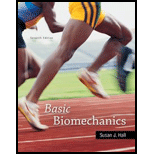
Basic Biomechanics
7th Edition
ISBN: 9780073522760
Author: Susan J Hall
Publisher: McGraw-Hill Education
expand_more
expand_more
format_list_bulleted
Concept explainers
Textbook Question
Chapter 12, Problem 2IP
A high jumper with a body weight of 712 N exerts a force of 3 kN against the ground during takeoff. How much force does the ground exert on the high jumper? (Answer: 3 kN)
Expert Solution & Answer
Trending nowThis is a popular solution!

Chapter 12 Solutions
Basic Biomechanics
Ch. 12 - How much force must be applied by a kicker to give...Ch. 12 - A high jumper with a body weight of 712 N exerts a...Ch. 12 - What factors affect the magnitude of friction?Ch. 12 - If s between a basketball shoe and a court is...Ch. 12 - A football player pushes a 670-N blocking sled....Ch. 12 - Lineman A has a mass of 100 kg and is traveling...Ch. 12 - Prob. 7IPCh. 12 - A ball dropped on a surface from a 2-m height...Ch. 12 - A set of 20 stairs, each of 20-cm height, is...Ch. 12 - A pitched ball with a mass of 1 kg reaches a...
Ch. 12 - Identify three practical examples of each of...Ch. 12 - Prob. 2APCh. 12 - A 2-kg block sitting on a horizontal surface is...Ch. 12 - Explain the interrelationships among mechanical...Ch. 12 - Prob. 5APCh. 12 - A 108 cm, 0.73-kg golf club is swung for 0.5 s...Ch. 12 - A 6.5-N ball is thrown with an initial velocity of...Ch. 12 - Prob. 8APCh. 12 - Using the principle of conservation of mechanical...Ch. 12 - Prob. 10AP
Knowledge Booster
Learn more about
Need a deep-dive on the concept behind this application? Look no further. Learn more about this topic, bioengineering and related others by exploring similar questions and additional content below.Recommended textbooks for you
- Lifetime Physical Fitness & WellnessHealth & NutritionISBN:9781337677509Author:HOEGERPublisher:Cengage
 Human Physiology: From Cells to Systems (MindTap ...BiologyISBN:9781285866932Author:Lauralee SherwoodPublisher:Cengage Learning
Human Physiology: From Cells to Systems (MindTap ...BiologyISBN:9781285866932Author:Lauralee SherwoodPublisher:Cengage Learning




Lifetime Physical Fitness & Wellness
Health & Nutrition
ISBN:9781337677509
Author:HOEGER
Publisher:Cengage

Human Physiology: From Cells to Systems (MindTap ...
Biology
ISBN:9781285866932
Author:Lauralee Sherwood
Publisher:Cengage Learning

Chapter 7 - Human Movement Science; Author: Dr. Jeff Williams;https://www.youtube.com/watch?v=LlqElkn4PA4;License: Standard youtube license